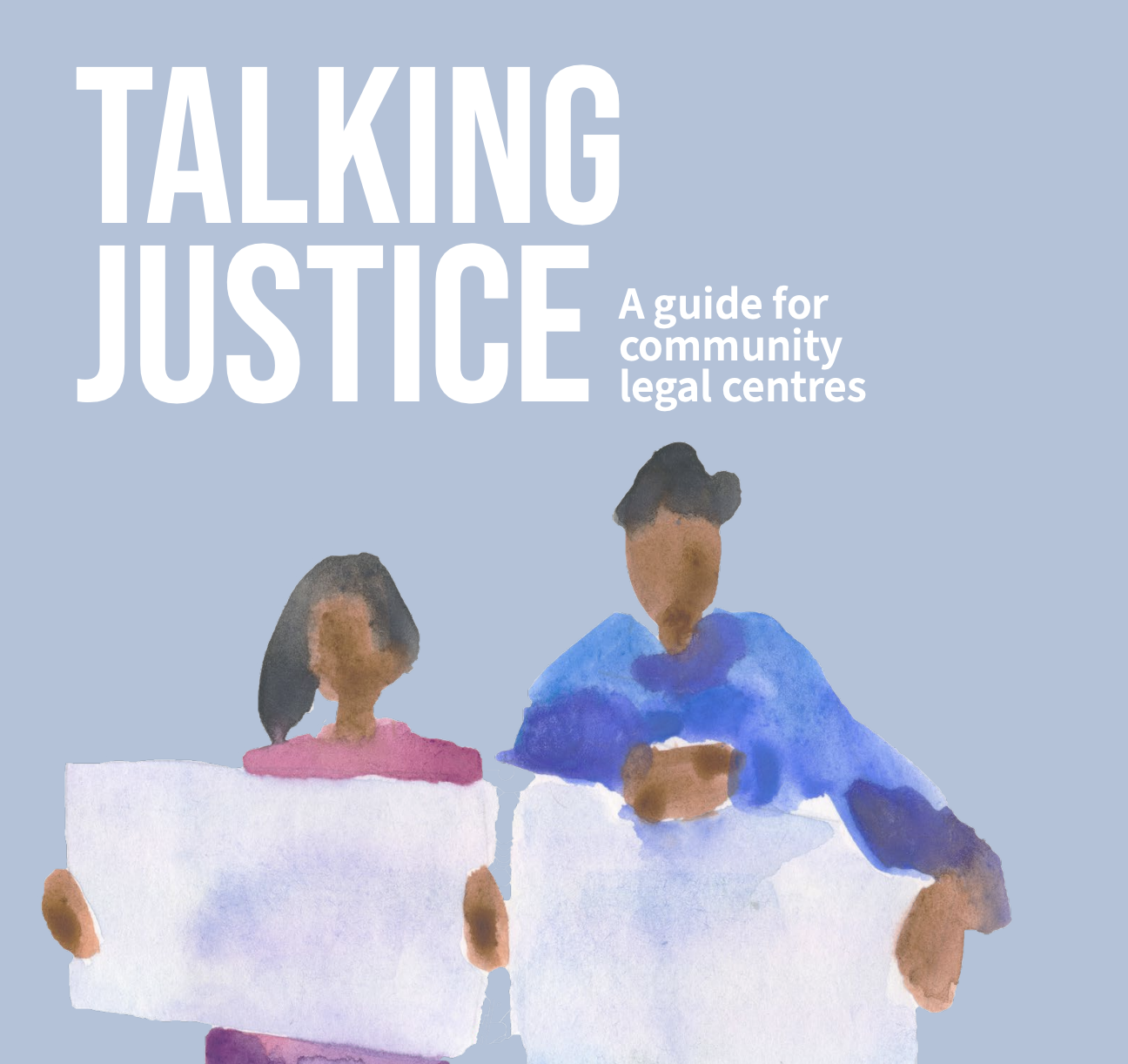Words matter when it comes to communicating about justice and inequality.
'Talking justice' is a values-based communications guide for community legal centres that provides guidance on:
- Using language that is respectful and humanising towards the people we support
- Reflects our values
- Boosts understanding of community legal centres
- Builds public support for policy and law reform
Download Talking justice: A guide for community legal centres
Key recommendations
Use the ‘people do things’ rule
When describing inequality or barriers to justice, name the source of the problem as specifically as possible. Stating problems without making clear who causes them can reinforce deficit narratives and turn systemic issues into individual failings. Use active voice. Assign an actor and a cause to the problems you describe – this shows a subject, person or thing that acts.Replace deficit language with strength-based stories
Deficit language – words like “vulnerable” and “disempowered” – can obscure the cause of harm or vulnerability. Tell stories that are grounded in strength, community knowledge, and truth, while recognising the injustices that people face.Tell our story (never negate)
Begin from the place of truth – say what we are for and what is, rather than what is not. This means not falling into the trap of busting myths.Be reader-friendly and use plain language
Communicating effectively means adjusting your message to suit your audience. Think about who you want to reach, and what forms of communication will enable those people or communities to understand, participate, and engage.Tell compelling stories of change
When communicating about policy or law reform, it’s important to be solutions focused. Talk about the outcomes and paint a picture of the future or transformational change that we want.Tell human stories
Foreground human stories, lived experience, and expertise. Facts, evidence and legal analysis are important, but messages that focus on statistics are dry and difficult to connect to.Lead with values and visions
Map out the values that underpin your message. Tell stories that activate collective and community strength, rather than individualistic or protective thinking.Know your audience
One-size-fits-all messages are rarely effective. Our language needs to be tailored to our different audiences, given that the people and organisations we communicate with are diverse. Tailoring our communications means that we can better meet the needs of different groups of people.
Additional resources
Reader friendly communication: A guide to using plain language | Reading Writing Hotline
This guide includes case studies of those currently providing a great model in making their communications more reader friendly, with a particular focus on addressing adult literacy barriers.
The Common Cause Handbook | Common Cause
A guide to values and frames for campaigners, community organisers, fundraisers, educators, activists, politicians, and everyone in between.
Framing issues guide | The Commons Social Change Library
A collection of research and recommendations for narrative and messaging on a range of issues.
Framing age Message guide | Common Cause Australia
This message guide contains recommendations that will help you talk about age, ageing and issues that affect older people in ways that reduce ageist attitudes and behaviours.
Messaging Guide: Drug stigma | Common Cause Australia & Smart Recovery Australia
This message guide has been written for people who talk about drugs and drugs policy in Australia, including those who use drugs themselves, and are concerned about the high levels of stigma associated with the issue.
The Power of Words: Having conversations about alcohol and other drugs | Alcohol and Drug Foundation
Professionals working in the health, education and justice sectors can dramatically reduce the impact of stigma by reconsidering how they think about people who use alcohol or other drugs (AOD) and choosing words that focus on people, rather than their AOD use.
Climate justice: Message guide | Framing Climate Justice
More than ever, we need to be fighting to win, to shift the narrative, and to build a movement for climate justice.
A guide to language about disability | People with Disability Australia
This guide has been written by people with disability to assist the general public and media outlets in talking about and reporting on disability.
Passing the Message Stick | Australian Progress
The results of a two-year research project to find messages that are effective in building public support for First Nations self-determination and justice.
Framing gender equality: Message guide | VicHealth
This messaging guide contains recommendations that will help you boost support for gender equality initiatives in Australia.
Voices for Change | Domestic Violence NSW
A report on the Voices for Change project, DVNSW’s first lived experience project aimed at addressing domestic, family and sexual violence through media advocacy.
Pride in Prevention: Messaging guide | Rainbow Health Australia
A guide for communications and engagement to support primary prevention of family violence experienced by LGBTIQ+ communities.
Change the story | Our Watch.
A shared framework for the primary prevention of violence against women in Australia.
How to talk about human rights | Anat Shanker-Osorio
Using language data from advocacy, opposition, political speech and popular culture, Anat Shenker-Osorio’s research analyses why certain messages resonate where others falter in the human rights sector across Australia, the UK and the US.
Talking about human rights in Australia | Human Rights Law Centre
Messaging guide for promoting an Australian Charter of Human Rights and Freedoms.
Words that work: Making the best case for people seeking asylum | Asylum Seeker Resource Centre
A guide on what language is most effective in persuading people to shift their ideas on people seeking asylum.
Legal information in languages other than English | Victoria Law Foundation
This research report outlines important factors to consider when producing legal information in languages other than English, including recommendations and best practice examples.
Legal glossary: A plain language guide to common legal terms | Victoria Law Foundation
This guide is intended to help non-lawyers understand legal phrases and to give lawyers guidance in explaining the legal phrases they use.
When I Tell My Story I’m in Charge: Ethical and Effective Storytelling in Advocacy | Rachael Ball
The challenge for progressive lawyers and activists is to develop a framework for storytelling that maximises systemic and sustainable advocacy outcomes and empowers participants while recognising and mitigating risks. The alternative is a policy and law reform agenda that relies on dry statistics and legal analysis and omits the insights and perspectives of people affected by injustice.
Raise the Age Messaging Guide | Raise the Age Campaign
A simple guide to talking to your friends, colleagues and local members of Parliament about why we need to #RaiseTheAge to keep children safe from prison, and invest in the alternatives that work.
Messaging guidance for restorative justice and rethinking discipline | Anat Shenker Osorio Communications
The purpose of this guide is to support advocates, educators, administrators, and allies in making the case to fund the programs and resources that make our schools safe for all while eliminating the police presence that directly impedes learning.
Policing, protest and racial injustice | Race Class Narrative Action
A guide of high-level suggestions on how to message about racial injustice, police violence, and protest.
How to talk about economics: A guide to changing the story | Australian Progress
The full guide is 50 pages long and details the research process, the key insights into how people reason about the economy, and detailed analysis of the key narrative and language shifts that move ‘persuadable’ audiences toward progressive policy.
Raise the Rate for Good campaign: A guide to telling the story | Australian Council of Social Service
This is a guide to support people and organisations in sharing their own story about why we need a permanent, adequate increase to JobSeeker, Youth Allowance and other payments.

